![]()
![]()
![]()
![]()

- V2 receiver can deliver almost 3 times more current than V1.
- V1 shows a current limitation at about 1 ampere. V2 driver is supposed to have a current limitation too (according datasheet, at 3.3A), but my 3A limited power supply didn't allow me to reach it.
- At high current, power loss in V2 is significantly lower than in V1.
LEGO® Power Functions Infrared Receivers

Power Functions infrared receiver exist in three version. The initial one, had a firmware bug in Single Pin mode. This bug was corrected in second version, identified by a short blink on the green LED when power is connected. Finally, a third version with a more powerful motor driver was introduced in 2012 in Rock Crawler set (9398).
The new driver chip used is a Texas Instruments DRV8833, while previous versions (hereafter collectively called "V1") use an On Semiconductor/Sanyo LB1836M. While many capabilities can be deduced from these datasheets (eg. nominal current per channel is 1.5A for DRV8833 vs. a mere 400mA for LB1836M), nothing beats some experiments to test the limits. So I couldn't resist doing an extensive comparison test...
Test setup
The setup is similar to the one I use to compare motors. The IR receiver is powered by a laboratory power supply, and one output is directed to the load (motor or power resistors) through Mindsensors CurrentMeter and VoltMeter (thanks to Mindsensors for these nifty devices!). Torque is again applied by weight lifting, but this time I used a hook and pulley to get longer test runs and more real life conditions. A HiTechnic IR-link is used to control the PF receiver by the NXT. Most tests were performed at 9V (nominal voltage of alkaline batteries) and 7.2V (nominal voltage of NiMH rechargeable cells).
No load consumption
This is the intrinsic power consumption of the receiver.
Not the most important parameter since it's pretty low compared
to motor current, but for the sake of completeness...
|
V1 |
V2 |
Idle |
17mA |
19mA |
Both outputs ON |
47mA |
|
Both outputs BRAKE |
73mA |
V2 consumption is constant, while V1 depends on active function and number of active outputs.
Pulse tests
In this test, we measure current and voltage that can deliver the IR receiver at various load levels. To get constant load, I used power resistors, instead of motor. Motor drivers have integrated current limitation, and also thermal protection (they shut down if they are getting too hot). Using short pulses, driver chip doesn't warm up, and thermal protection doesn't trip. More precisely, outputs are activated, and half a second later, we measure current and voltage, then shut down outputs, see NXC program here.
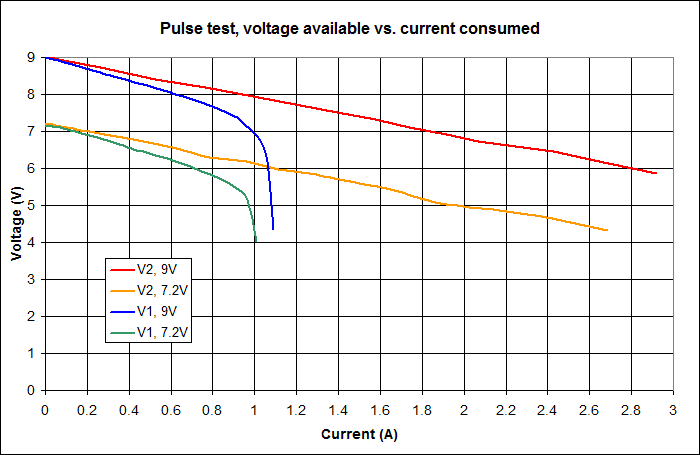
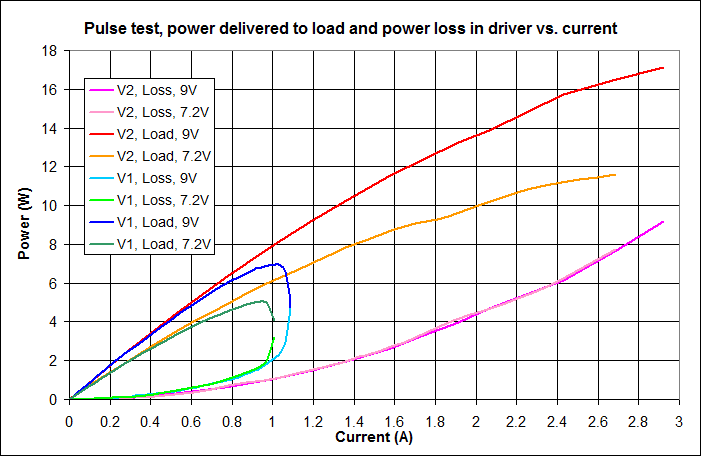
Endurance tests
This time, we load receivers and let them run for one minute. At high load, temperature in motor driver raises. When there is a risk to go above safe value, the driver shuts down its outputs and will restore them only after it has cooled down enough. If the load is still there, this cycle repeats, resulting in a "hiccup" behaviour.
- V1 receiver
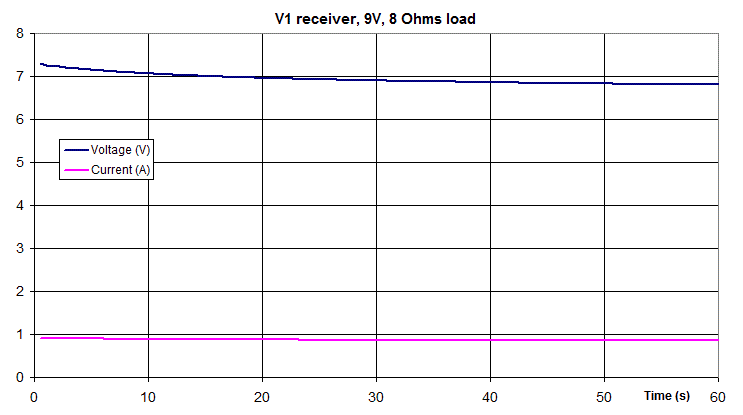
If the current is low enough, thermal shutdown
is not activated. Only one output is loaded, with a 8 Ohms resistor.
Current is about 900mA. We see that V1 receiver is able to deliver
about 6W to the load.

With a slightly higher load, thermal shutdown
is rapidly activated.
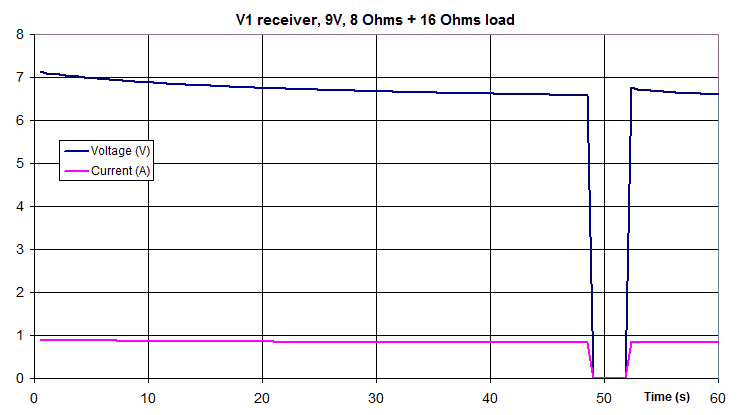
Thermal losses in both channels add up. The
second output is activated (here it delivers 500mA on a 16 Ohms
resistor).
Though each channel is not heavily loaded, we
see that thermal shutdown occurs...
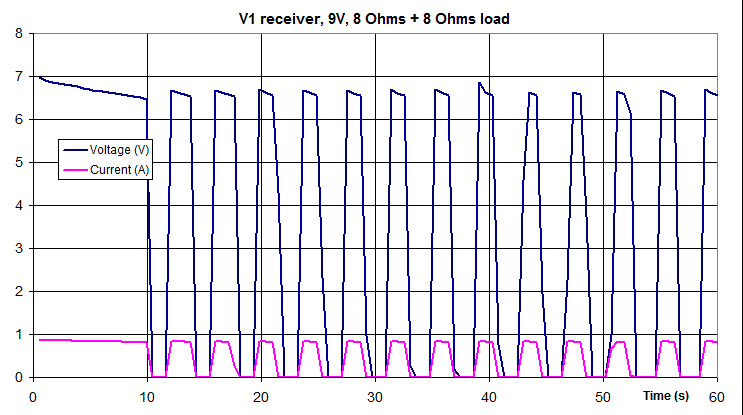
...and with a higher load on the second output,
hiccup occurs faster (obviously!). This means that it may be
a good idea
to separate high power motors on different receivers
(but the remote control ergonomics may suffer!)
- V2 receiver
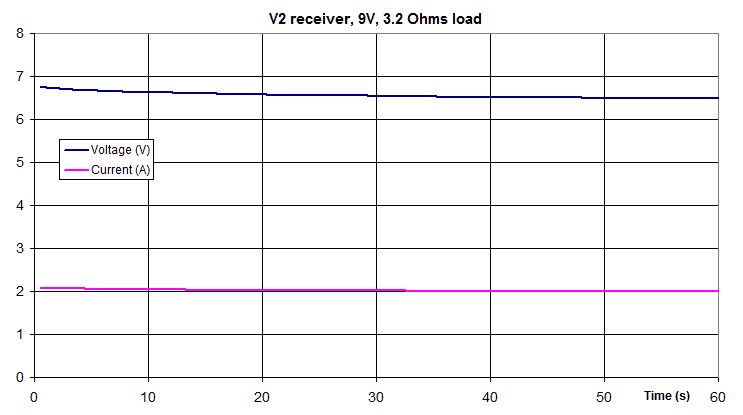
V2 receiver is able to drive a 3.2 Ohms load
at 2A, providing 13W to the load (more than twice the capability
of V1!).
Note that at this current
level, current limitation of the battery pack starts to become
a problem!

Thermal protection trips at 2.2A.
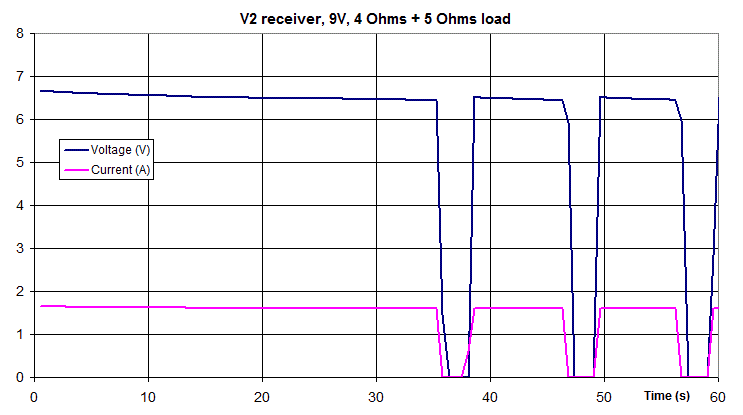
If the second output is loaded (1.3A), protection
occurs at a lower current (1.6A).
This again shows that
it may be a good idea to avoid grouping together powerful motors
on the same receiver.
Power dissipated in driver depends little on receiver supply voltage, as we saw in pulse tests. So thermal shutdown occurs at roughly the same current when using 7.2V supply.
Real world testing...
In order to make a more realistic test, I built a simple vehicle. I used a power hungry 5292 RC buggy motor to stress the IR receivers. The video below shows the compared behaviour of V1 and V2 receivers.
http://www.youtube.com/embed/KCM4Ug1bPrM?rel=0As you can see V2 receiver performs a lot better than V1... but only if the battery pack is up to the task! Regular Power Functions AA battery pack simply can't provide enough current to allow V2 reach its full potential. Each channel of V2 receiver can provide 1.5A continuous, totalling 3A. Internal resettable fuse of AA battery pack is a Bourns MF-MSMF075 rated only 750mA. Looking at the datasheet, you see that at ambient temperature, it trips in 20 seconds at 1.5A and 0.8 seconds at 3A!!!
That said, I can't recommend shorting the protection as I did in the video! In case of problem (eg. cable short) this could result in deterioration of battery box switch or cable contacts - and even burning/fire! Replacing the fuse with a higher rating one (eg. a MF-MSMF150) would probably be a good compromise between safety and performance.
Motor curves
Curves showing performance of various motors and motor pairs driven by PF receivers are available here.
![]()

![]()
![]()
![]()